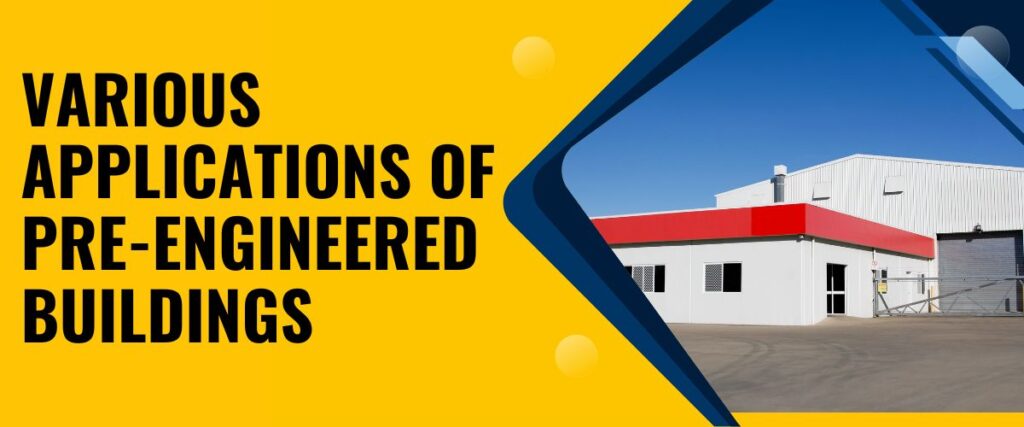
The Various Applications of Pre Engineered Buildings
Pre-engineered buildings are versatile structures designed and fabricated off-site, tailored to meet specific requirements and assembled on-site. These buildings offer numerous advantages, including cost-effectiveness, design flexibility, and shorter construction timelines. Understanding the various applications of pre-engineered buildings can help businesses and individuals make informed decisions when considering their construction projects.
Industrial Applications
PEB find extensive use in industrial settings due to their ability to accommodate large open spaces and heavy machinery. They are commonly employed in:
Warehousing and Distribution Centers
Pre-engineered buildings provide ample storage space for inventory management, order fulfillment, and logistics operations. The clear-span design allows unobstructed movement of goods and efficient use of vertical space.
Manufacturing Facilities/Factory Shed
These buildings provide a suitable environment for manufacturing processes, including assembly lines, production floors, and material handling areas. The flexible layout options and column-free interiors enable efficient workflow and equipment placement.
Automotive and Aerospace Industries
Pre-engineered buildings serve as workshops, garages, and maintenance facilities for automotive and aerospace companies. These structures provide ample space for vehicle assembly, maintenance, and storage.
Power Plants and Utility Structures
These buildings house equipment and machinery for power generation, substations, and utility infrastructure. Their robust design and ability to withstand heavy loads make them ideal for housing transformers, generators, and control rooms.
Commercial Applications
Pre-engineered buildings are also extensively used in commercial settings, offering flexibility in design and cost-effective construction solutions. Common applications include
Retail Stores and Shopping Complexes
Pre-engineered buildings provide customizable retail spaces that cater to various commercial needs. They offer wide-open interiors, allowing retailers to design attractive and functional spaces.
Office Buildings and Corporate Centers
These structures accommodate office spaces, conference rooms, and common areas for businesses of all sizes. The flexibility in design allows for customizable layouts, meeting the unique requirements of different organizations.
Exhibition Halls and Convention Centers
Pre-engineered buildings offer vast column-free spaces for exhibitions, trade shows, and conventions. Their spacious interiors can be easily modified to accommodate different booth sizes and layouts.
Sports Arenas and Stadiums
These buildings provide large venues for sporting events and entertainment purposes. The design flexibility enables the incorporation of spectator seating, changing rooms, and other amenities required for hosting events.
Institutional Applications
Pre-engineered buildings are commonly used in institutional settings, meeting the specific needs of educational, healthcare, and government facilities. Some common institutional applications include
Schools, Colleges, and Universities
Pre-engineered buildings provide cost-effective solutions for educational institutions, including classrooms, libraries, laboratories, and administrative offices. The design flexibility allows for future expansions and modifications.
Healthcare Facilities and Hospitals
These structures accommodate medical offices, clinics, outpatient facilities, and hospitals. The ability to customize layouts to specific medical requirements ensures efficient patient flow and staff coordination.
Government Buildings and Offices
Pre-engineered buildings offer versatile solutions for government offices, administrative centers, and municipal facilities. Their customizable designs accommodate various departments and services.
Community Centers and Recreational Facilities
These buildings provide multi-purpose spaces for community gatherings, events, and recreational activities. Their large spans and open layouts allow for flexible use and easy adaptability to different functions.
Specialized Applications
Pre-engineered buildings find application in specialized areas that require specific infrastructure solutions. Some notable specialized applications include
Disaster Relief Structures
Pre-engineered buildings play a crucial role in emergency situations, providing temporary shelters, medical facilities, and command centers during disasters or humanitarian crises.
Grain Storage and Processing Facilities
Pre-engineered buildings offer secure and weather-resistant spaces for storing grains and other agricultural produce. They can be customized with ventilation systems, moisture control, and conveyors for efficient handling and processing.
Godown Shed/Farm Equipment Storage Structures
These buildings offer protection for farm machinery and equipment, preventing damage from weather conditions and theft. The clear-span design allows for easy movement of large machinery.
Airports and Hangars
Pre-engineered buildings serve as airport terminals, hangars, and maintenance facilities for aircraft. Their large spans accommodate aircraft movements, storage, and maintenance operations.
Bus and Train Stations
These buildings serve as transportation hubs, accommodating waiting areas, ticket counters, and other facilities for commuters. The design flexibility allows for easy integration with transportation systems.
Cold Storage Facilities
These buildings offer controlled temperature environments for storing perishable goods, such as food and pharmaceuticals. Insulated panels and specialized refrigeration systems ensure proper storage conditions.
Pre-engineered buildings offer a wide range of applications across various industries and sectors. From industrial and commercial settings to agricultural, institutional, infrastructure, and specialized needs, these structures provide cost-effective, durable, and customizable solutions. Understanding the versatility and advantages of pre-engineered buildings enables businesses and individuals to make informed decisions when considering construction projects, leading to successful outcomes and long-term satisfaction.

